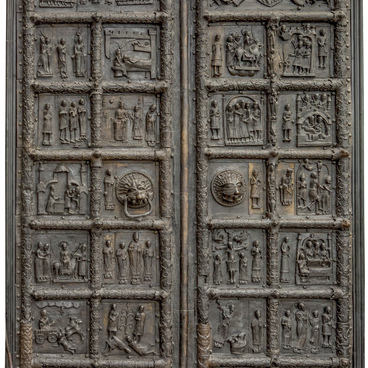The folding triptych “The Miracle of the Great Martyr George and the Dragon” with St. George’s crosses attached to it is one of the relics of the Rostov Grenadier Regiment. This unit — one of the oldest in the Russian army — was quartered in Moscow, in the Spassky Barracks, since 1728. This is probably why the image of St. George the Dragonslayer is depicted in the middle of the folding icon — its central part, as he was considered the patron saint of Moscow.
The central panel of the folding icon was painted presumably in 1836. This hypothesis is based on a later inscription, which is located on the back. In 1882, as the inscription under the image of St. George states, “the icon was restored through the efforts of the soldiers of lower ranks of the 13th Company of the 2nd Rostov Grenadier Regiment, led by Captain Alekseyev”. At the same time, St. George crosses and a plaque with the names of soldiers who died in 1877 during the Russian-Turkish war were attached to the icon. It is likely that in 1882, the flanking panels with images of two saints — Alexander Nevsky and Prince Vladimir, Equal-to-the-Apostles — were created for the folding icon as well.
George the Victory-Bearer, whose image is depicted in the central panel of the triptych, is one of the most famous and revered Christian saints. He is traditionally depicted on a horse, with a spear in his hands: with this weapon, the saint strikes a mythical monster — either a dragon or a snake depending on the source. Icon painters took this episode from George’s hagiography (biography of a saint). It tells the story of how he saved a princess from death, who was chosen by her own father to be sacrificed to the serpent. The Greek tradition considers this event to be the only lifetime miracle of George: all others are posthumous.
The first icons with a similar composition appeared in the 10th–11th centuries. At first, the canonical image was detailed and multi-figured: both the rescued princess and her monarch father were painted in the icons, surrounded by his retinue and soldiers. Later, an abridged version appeared, in which George and the serpent became the focal point, and either the hand of Christ or an angel with a wreath were depicted above the saint’s head. In the Western tradition, George strikes the dragon in the eye, whereas in Russian icons — in its gaping mouth.
The central panel of the folding icon was painted presumably in 1836. This hypothesis is based on a later inscription, which is located on the back. In 1882, as the inscription under the image of St. George states, “the icon was restored through the efforts of the soldiers of lower ranks of the 13th Company of the 2nd Rostov Grenadier Regiment, led by Captain Alekseyev”. At the same time, St. George crosses and a plaque with the names of soldiers who died in 1877 during the Russian-Turkish war were attached to the icon. It is likely that in 1882, the flanking panels with images of two saints — Alexander Nevsky and Prince Vladimir, Equal-to-the-Apostles — were created for the folding icon as well.
George the Victory-Bearer, whose image is depicted in the central panel of the triptych, is one of the most famous and revered Christian saints. He is traditionally depicted on a horse, with a spear in his hands: with this weapon, the saint strikes a mythical monster — either a dragon or a snake depending on the source. Icon painters took this episode from George’s hagiography (biography of a saint). It tells the story of how he saved a princess from death, who was chosen by her own father to be sacrificed to the serpent. The Greek tradition considers this event to be the only lifetime miracle of George: all others are posthumous.
The first icons with a similar composition appeared in the 10th–11th centuries. At first, the canonical image was detailed and multi-figured: both the rescued princess and her monarch father were painted in the icons, surrounded by his retinue and soldiers. Later, an abridged version appeared, in which George and the serpent became the focal point, and either the hand of Christ or an angel with a wreath were depicted above the saint’s head. In the Western tradition, George strikes the dragon in the eye, whereas in Russian icons — in its gaping mouth.



